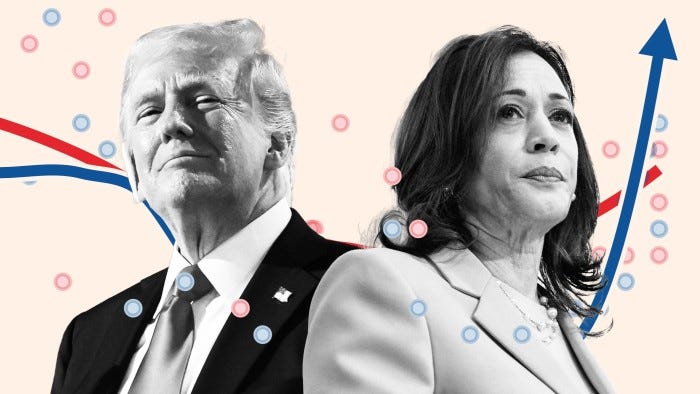Forecasting Electoral Outcomes: The Impact of Economic Indicators on U.S. Presidential Elections
Analyzing Historical Data and Projecting the 2024 Election with Six Key Economic Metrics
Predicting election outcomes is a multifaceted challenge that often hinges on the economic context in which voters find themselves. Economic indicators provide valuable insights into voter sentiment, as the economy's perceived health can heavily influence electoral behavior. This essay explores a predictive model based on six key economic indicators, examining how these factors played out in the 2004, 2012, and 2020 U.S. presidential elections and providing a projection for the upcoming 2024 election.
Key Economic Indicators
The model utilizes six economic indicators, each representing critical aspects of the economic landscape that can impact voter preferences:
Real Disposable Personal Income (Real Income):
Definition: This measures the income available to households after accounting for taxes and inflation. It is a direct indicator of consumer purchasing power and economic well-being.
Role in Model: A rise in real income typically signals economic prosperity, boosting the incumbent party's prospects as voters feel financially secure.
Consumer Price Index (CPI):
Definition: The CPI measures the average change over time in the prices paid by consumers for goods and services, serving as a primary indicator of inflation.
Role in Model: Stable or low inflation is favorable for incumbents, as it maintains consumer purchasing power and reflects economic stability.
Nonfarm Payrolls:
Definition: This metric tracks the total number of jobs added or lost in the economy, excluding certain sectors like agriculture and government. It is a crucial indicator of labor market health.
Role in Model: Strong job growth often indicates a robust economy, benefiting the incumbent party by showcasing effective economic management.
Industrial Production:
Definition: Industrial production measures the output of the industrial sector, including manufacturing, mining, and utilities. It reflects the overall health of the economy's production capabilities.
Role in Model: Increased industrial production signals economic strength and growth, which can positively influence voter sentiment toward incumbents.
Personal Consumption Expenditures (PCE):
Definition: PCE measures consumer spending on goods and services, providing insights into consumer confidence and economic activity.
Role in Model: Higher personal consumption typically indicates economic confidence, suggesting voter satisfaction with the current administration.
S&P 500 Performance:
Definition: The S&P 500 index represents the stock performance of 500 large companies in the U.S., serving as a benchmark for overall market health.
Role in Model: A rising stock market often reflects investor confidence and economic optimism, which can enhance the incumbent's electoral prospects.
Model Prediction Equation
Predicted Vote Percentage:
Where:
aaa is the intercept,
are the coefficients for each indicator.
Model Analysis: Historical Elections
2004 Election
Economic Indicators:
Real Income: 2.6%
CPI: 2.7%
Nonfarm Payrolls: 1.1%
Industrial Production: 4.1%
Personal Consumption: 5.1%
S&P 500: 8.99%
Model Prediction: 51.39%
Actual Vote Percentage: 50.70%
MAE: 0.69, RMSE: 0.69
Analysis: The model predicted a slight overestimate of the incumbent's vote percentage. The economic indicators showed a stable economy, which likely contributed to President George W. Bush's re-election.
2012 Election
Economic Indicators:
Real Income: 2.1%
CPI: 2.1%
Nonfarm Payrolls: 2.2%
Industrial Production: 3.3%
Personal Consumption: 4.3%
S&P 500: 13.41%
Model Prediction: 49.85%
Actual Vote Percentage: 51.10%
MAE: 1.25, RMSE: 1.25
Analysis: The model slightly underestimated the incumbent's performance. Economic indicators reflected a recovering economy post-recession, aiding President Barack Obama's re-election despite the model's conservative prediction.
2020 Election
Economic Indicators:
Real Income: 6.4%
CPI: 1.2%
Nonfarm Payrolls: -9.4%
Industrial Production: -7.2%
Personal Consumption: -2.5%
S&P 500: 16.26%
Model Prediction: 51.22%
Actual Vote Percentage: 46.80%
MAE: 4.42, RMSE: 4.42
Analysis: The model overestimated the incumbent's vote share, largely due to the atypical conditions of 2020, including the COVID-19 pandemic, which significantly disrupted normal economic patterns and voter behavior.
Projection for the 2024 Election
Economic Indicators:
Real Income: -0.8%
CPI: 3.1%
Nonfarm Payrolls: 2.1%
Industrial Production: 1.0%
Personal Consumption: 2.9%
S&P 500: 14.3%
Predicted Vote Percentage: 50.97%
Analysis: The model predicts a close race for 2024, with economic indicators suggesting a moderately favorable environment for the incumbent party. The projection reflects a competitive election landscape, indicating that non-economic factors may play a significant role in determining the outcome.
Conclusion
The use of economic indicators in predicting election outcomes offers valuable insights into the relationship between economic conditions and voter behavior. While the model demonstrates a reasonable degree of accuracy, especially for the 2004 and 2012 elections, the 2020 anomaly highlights extenuiating circumstances outside of economic factors only. As we look toward the 2024 election, understanding how economic indicators influence voter sentiment will be crucial for anticipating electoral dynamics.




